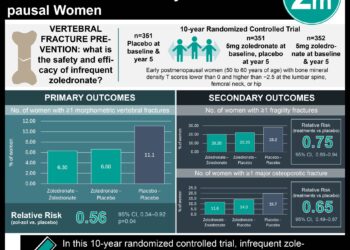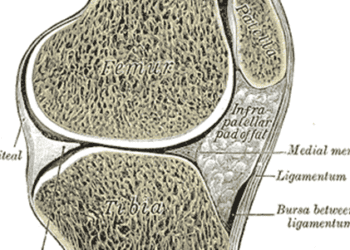Plastin 3 protein mutations may be involved in osteoporosis
Image: PD
1. Pathogenic variants of the plastin 3 (PLS3) gene were identified in five families with X-linked osteoporosis and osteoporotic fractures.
2. A rare PLS3 variant was found to be associated with decreased BMD and increased risk of fracture among elderly heterozygous women.
3. Zebrafish with pls3 knockdown developed skeletal malformations that were reversible with administration of human PLS3 mRNA.
Evidence Rating Level: 2 (Good)
Study Rundown: Osteoporosis is a multifactorial disease with a complex pathophysiology involving both genetic and environmental factors. In this study, analyses of genomic data from families with X-linked osteoporosis led to the identification of several novel PLS3 gene variants. The study findings suggest that the PLS3 protein is important to bone health and that variants in its gene may have a role in multifactorial osteoporosis. The authors hypothesize that the PLS3 protein is important in the mechanosensitivity of osteocyte dendrites. Thus, mutations in PLS3 would result in decreased mechanosensing, leading to dysregulation of bone modeling or remodeling and ultimately to osteoporosis. The association between the rare PLS3 gene variant and osteoporosis was examined in a population of Dutch men and women. Additional studies with larger cohorts and greater ethnic variability are needed to further assess this relationship in the general population.
Click to read the study in NEJM
Relevant Reading: Recent progress in understanding the genetic susceptibility to osteoporosis
In-Depth [prospective cohort study]: This study analyzed the genomes of families with X-linked osteoporosis and fractures without mutations in collagen type Iα1 or type Iα2 genes. Families 1 to 5 carried pathogenic variants for PLS3 and families 6 to 10 had been referred based on suspicion of osteogenesis imperfect type I. A single deleterious hemizygous frameshift in exon 3 of PLS3 was discovered through X-linked whole-exome sequencing of affected males from Family 1. Subsequent Sanger sequencing of all PLS3 exons in 95 affected male patients revealed four additional pathogenic variants in families 2 through 5 and a rare variant in families 6 through 10.
Genotyping for the rare variant was conducted in the three cohorts of the Rotterdam Study, a Dutch study analyzing the association of genetic factors with bone mineral density (BMD) and fractures. Heterozygous female carriers of the rare variant of PLS3 had significantly increased risk of fracture as compared to noncarriers. Fixed-effect model analysis of two of the cohorts found the odds ratio of fracture to be 1.95 (95% CI, 1.39 to 2.74; P<0.001). Combined analysis of the three Rotterdam Study cohorts showed a small but significantly decreased BMD at the lumbar spine and femoral neck in heterozygous women (P=0.008, and P=0.04, respectively). No significant difference was found in men.
In vivo studies of zebrafish found that PLS3 knockdown led to severe dysplasia of craniofacial skeletal elements. In addition, knockdown zebrafish larvae developed gross morphologic abnormalities that were specific and reversed dose-dependently with injections of human PLS3 mRNA.
By Xu Gao and Adrienne Cheung
© 2013 2minutemedicine.com. All rights reserved. No works may be reproduced without expressed written consent from 2minutemedicine.com. Disclaimer: We present factual information directly from peer reviewed medical journals. No post should be construed as medical advice and is not intended as such by the authors, editors, staff or by 2minutemedicine.com. PLEASE SEE A HEALTHCARE PROVIDER IN YOUR AREA IF YOU SEEK MEDICAL ADVICE OF ANY SORT.





